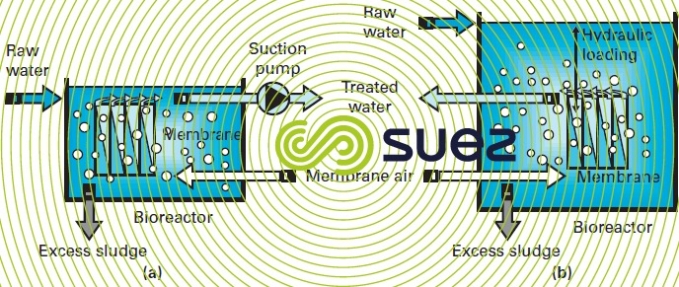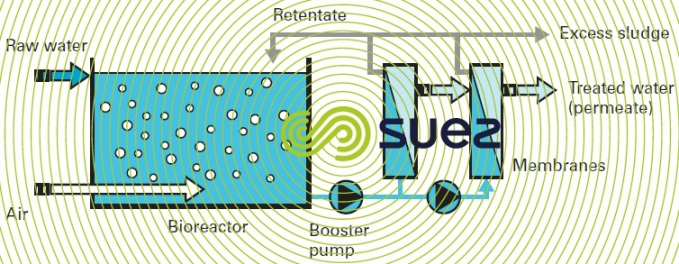Exactly How Membrane Layer Bioreactors Are Transforming Water Purification Systems
The appearance of membrane layer bioreactors (MBRs) represents a considerable innovation in the field of water filtration, merging biological treatment processes with sophisticated membrane filtration technologies. As worldwide water deficiency escalates, the role of MBRs in facilitating drinkable water reuse and sustainable water administration comes to be progressively essential.
Overview of Membrane Bioreactors
Membrane layer bioreactors (MBRs) represent a significant innovation in water purification innovation, as they integrate organic treatment processes with membrane filtering. This combination boosts the performance of wastewater therapy by using bacteria to deteriorate natural pollutants while simultaneously using semi-permeable membranes to separate treated water from suspended solids and virus.
The MBR system normally includes a biological activator where the microbial populace metabolizes impurities, complied with by a membrane filtration system that retains biomass and allows only clean water to go through. This dual capability results in higher effluent high quality contrasted to conventional therapy techniques. MBRs can be operated in both batch and continuous flow modes, supplying flexibility in design and application.
In Addition, MBRs are identified by their portable impact, making them suitable for urban setups with space restraints. Membrane Bioreactor. They likewise make it possible for the recovery of water for reuse, thus adding to water sustainability efforts. While MBR modern technology has acquired popularity in industrial and municipal applications, its functional intricacies and power needs necessitate careful consideration throughout implementation. On the whole, MBRs go to the forefront of improving water therapy effectiveness and quality, showcasing the potential for innovative options in ecological administration.
Advantages of MBR Technology
The combination of organic therapy with membrane purification offers numerous benefits for water purification processes. One of the key benefits of Membrane Bioreactor (MBR) innovation is its ability to effectively remove both natural and inorganic pollutants, bring about high-grade effluent. The membranes work as a physical barrier, preventing suspended solids and pathogens from passing through, which enhances the overall security and reliability of treated water.
Additionally, MBR systems need a smaller footprint compared to standard therapy approaches, permitting extra reliable area utilization. This small layout is particularly beneficial in urban setups where land is limited. MBRs additionally show operational versatility, fitting varying influent high qualities and circulation prices without considerable efficiency degradation.
Furthermore, the process uses improved nutrient removal capacities, particularly for nitrogen and phosphorus, which are critical for stopping eutrophication in receiving waters. The reduced sludge manufacturing related to MBR modern technology also equates to lower disposal expenses, making it an economical option over time - Membrane Bioreactor. Generally, the benefits of MBR innovation placement it as a leading choice for ingenious and lasting water purification systems, dealing with both ecological and economic concerns
Applications in Water Filtration
Applications of Membrane Bioreactor (MBR) innovation in water filtration are diverse and impactful, addressing numerous therapy needs across numerous fields. MBRs properly incorporate biological therapy processes with membrane layer filtering, making them excellent for community wastewater treatment, industrial effluent administration, and even potable water reuse initiatives.
In metropolitan settings, MBRs are progressively used to boost the quality of treated wastewater, permitting compliance with rigorous discharge policies blog here and assisting in the recycling of water for watering and non-potable usages. Their compact style also check my site makes them ideal for urban environments where room is limited.
Industrially, MBR modern technology is made use of to treat process water and wastewater, especially in sectors such as food and drink, pharmaceuticals, and textiles. By effectively removing pollutants and suspended solids, MBRs assist sectors lessen ecological impacts while recuperating useful sources from wastewater streams.
Furthermore, MBRs are getting grip in decentralized water therapy applications, where small systems can be deployed in remote locations or establishing regions. This flexibility allows communities to accomplish sustainable water monitoring services, boosting access to clean water while minimizing dependence on typical therapy approaches.
Study and Success Stories

In an additional instance, a fabric manufacturing center in Bangladesh embraced MBR modern technology to address its wastewater obstacles. The system decreased chemical oxygen need (COD) degrees from 1,200 mg/L to less than 100 mg/L, thus meeting regulatory standards and significantly reducing ecological influence.
The College of Cape Community's MBR installation has verified reliable in dealing with greywater for non-potable reuse on campus. This project not only preserves potable water but also functions as an academic design for sustainable methods.
Moreover, a fish and shellfish processing plant in Norway made use of MBR modern technology to treat effluents having high levels of natural issue, achieving over 90% toxin removal. These study emphasize MBR modern technology's adaptability and its essential function in boosting water high quality throughout varied applications.
Future of Water Treatment Solutions
As international water deficiency and air pollution challenges escalate, innovative water treatment services are ending up being increasingly crucial have a peek here to make sure lasting accessibility to tidy water. The future of water treatment exists in the combination of innovative modern technologies that boost the efficiency and efficiency of filtration procedures. Membrane layer bioreactors (MBRs) are at the forefront of this development, integrating organic treatment with membrane filtration to produce high-quality effluent ideal for numerous applications.

Emerging patterns such as resource healing from wastewater, including nutrients and power, will certainly further transform therapy facilities right into green centers. Moreover, advancements in nanotechnology and membrane materials promise enhanced efficiency and long life of filtration systems.

Final Thought
Their role in drinkable water reuse and lasting water administration highlights their significance in attending to worldwide water shortage difficulties. Continued study and advancement will certainly better boost the efficacy and fostering of MBR modern technology, ensuring a resistant future for water therapy services.
The appearance of membrane bioreactors (MBRs) stands for a substantial advancement in the field of water purification, combining organic therapy procedures with cutting-edge membrane filtration modern technologies. As global water deficiency increases, the function of MBRs in promoting drinkable water reuse and lasting water management ends up being progressively important. They also make it possible for the healing of water for reuse, therefore contributing to water sustainability initiatives.As international water scarcity and air pollution obstacles magnify, innovative water therapy options are ending up being increasingly vital to make certain sustainable access to clean water. Their role in safe and clean water reuse and lasting water administration highlights their importance in resolving worldwide water scarcity obstacles.